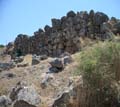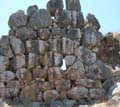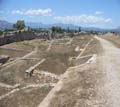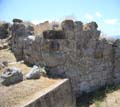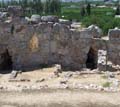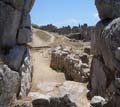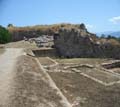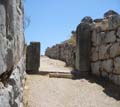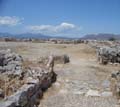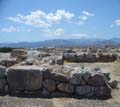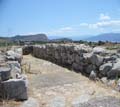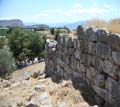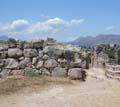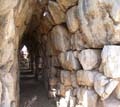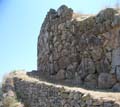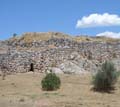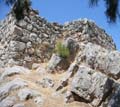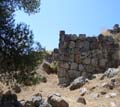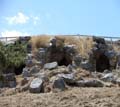
(tel. 27520 22657)
The low hill of Tiryns, at the 8th kilometer of the Argos-Nafplio road, was continuously inhabited from the Neolithic era until late antiquity. During prehistoric times the area flourished mainly during the early and late Bronze Age. In the second phase of the Proto-Hellenic era (2700-2200 BC) there must have been an important center here with a dense population and a uniquely constructed circular building, 27 m in diameter, on the top of the hill. During the late Bronze Age the hill was gradually fortified and surrounded within its "cyclopean" walls the palace complex as well as other buildings used mainly by the ruling class as places of worship, warehouses and workshops but also as residences. In historical times, Tiryns, although it must have had the form of an organized political community, could not compete with Argos, which destroyed it in the first half of the 5th century and exiling its inhabitants.
The traveler Pausanias who visited it in the 2nd century AD. he found it in ruins. During the Byzantine era, a cemetery church was established on the Upper Acropolis and possibly a small settlement to the west of the Acropolis. The end of the now insignificant settlement must be connected with the conquest of Argos by the Turks in 1379 AD. In Venetian sources, Tiryntha is referred to as Napoli vecchio, while the name Tiryntha is given again to the area in modern times, replacing the usual name "Paleokastro". In 1828, a building for the operation of a rural school was founded by the governor Ioannis Kapodistrias in the area south of the Acropolis. Today, it houses the rural prisons. After the travelers of the 17th and 19th centuries (Des Mouceaux, Dodwell, Leake) Tiryns was discovered in 1876 by Henry Schliemann who, with his extensive excavations in 1884/5, handed it over to archaeological research.
As the mythical founder of Tiryns, the Argean prince Proitos, who fled after the dispute with his brother Acrisius to Lycia, is handed down. On his return he brought with him the Cyclopes who built the magnificent walls for him. Moreover, the mythical heroes Bellerephontis and Perseus, as well as the demigod Heracles, are also associated with Tiryns.
The investigations of the German Archaeological Institute and the Hellenic Archaeological Service, from 1876 until today, brought to light one of the most important Mycenaean citadels and traced the stages of the civilization of the prehistoric and historical periods of the Argolis. After the pioneers Heinrich Schliemann and Wilhelm Dfrpfeld (1884-1885), the area was explored in the first half of the twentieth century by Georg Karo and Kurt Moller. At the end of the 1950s, the Superintendent of Antiquities of Argolis Nikolaos Verdelis undertook the task of restoring the western side of the fortification that had collapsed and was covered by the rubble of the old excavations. After 1967 the excavations were again assigned to the German Archaeological Institute, which under the direction of Ulf Jantzen, Jfrg Schδfer, Klaus Kilian and Joseph Maran continue the investigations including the Lower Acropolis and the Lower City. At the same time, the local Ephorate of Antiquities conducts excavations both in the visited archaeological site and in the wider area.
The revelation through the excavations of a monument that was protected for many centuries under the soil of abandonment and its long-term exposure without maintenance care to weather conditions and the action of visitors, caused significant damage to the archaeological site. With the actions of the 4th Ephorate of Prehistoric and Classical Antiquities, the competent regional Service of the Ministry of Culture and the direct support of the Peloponnese Region, the monument was included in the projects financed by the 2nd and 3rd Community Support Frameworks. The participation of the German Archaeological Institute, which financed the studies of the German architect Jan Martin Klessing carried out in Tiryns in the last decade, was also decisive. During this time, a large number of collaborators (archaeologists, designers, skilled and unskilled workers) participated in the program of upgrading one of the most important archaeological sites of Argolis that has been included in the list of UNESCO's world cultural heritage sites. In addition, under the responsibility of the Department of Restoration of Ancient Monuments of the Ministry of Culture, construction work was carried out on the archaeological site to be visited, which now includes organized routes, visitor service buildings, a new entrance and a parking area.
Editor Dr. Alkistis Papadimitriou










